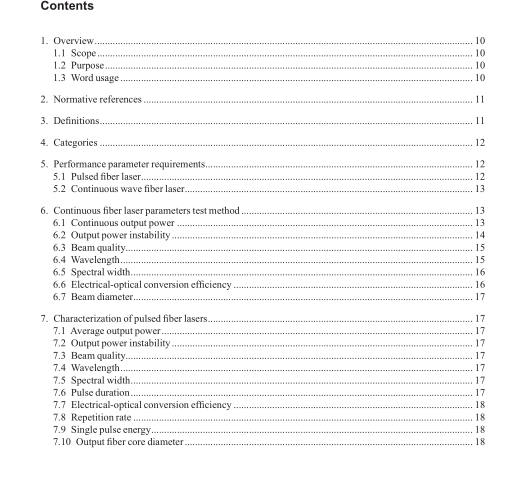IEEE 2065-2020 pdf download.IEEE Guide for Parameter Requirements and Test Method for Industrial Fiber Laser
This guide specifies the required parameters that should be included in an industrial fiber laser product, such as the terminology, classification, test method, for fiber laser product.
This guide is intended to be used by fiber-laser producers, laser-processing equipment integrators, and end-users.
1.2 Purpose This guide aims to help manufacturers to produce reliable industrial fiber lasers that conform to the parameter requirements suggested by this guide. Having a uniform specification will help mitigate unnecessary confusion and technical obstacles caused by different parameters by different fiber laser providers.
1.3 Word usage
The word shall indicates mandatory requirements strictly to be followed in order to conform to the standard and from which no deviation is permitted (shall equals is required to).
The word should indicates that among several possibilities one is recommended as particularly suitable, without mentioning or excluding others; or that a certain course of action is preferred but not necessarily required (should equals is recommended that).
The word may is used to indicate a course of action permissible within the limits of the standard (may equals is permitted to). The word can is used for statements of possibility and capability, whether material, physical, or causal (can equals is able to).
2. Normative references
The following referenced documents are indispensable for the application of this document (i.e., they must be understood and used, so each referenced document is cited in text and its relationship to this document is explained). For dated references, only the edition cited applies. For undated references, the latest edition of the referenced document (including any amendments or corrigenda) applies.
IEC 60825-1:2014, Safety of laser products—Part 1: Equipment classifcation and requirements. 3
ISO/TR 11146-3, Lasers and laser-related equipment—Test methods for laser beam widths, divergence angles and beam propagation ratios—Part 3: Intrinsic and geometrical laser beam classifcation, propagation and details of test methods. 4
3. Defnitions
For the purposes of this document, the following terms and definitions apply. The IEEE Standards Dictionary Online should be consulted for terms not defined in this clause.
5
beam attenuator: A device used to reduce laser radiation to or below a specifed level. Beam attenuators selected to measure beam-related parameters shall not affect the beam energy distribution.
beam diameter: The diameter of the circular contour in the beam cross section at which the laser power (energy) density is 1/e 2 of the peak maximum (IEC 60825-1:2014). 6
beam expander: A combination of optical elements is capable of increasing laser beam diameter.
beam quality: A measure used to evaluate the beam focusing ability. In this standard, the laser beam quality is evaluated by the M 2 factor, and M 2 is the ratio of the product of the beam waist radius and the beam divergence angle to the product of an ideal Gaussian beam waist radius and beam divergence angle.
continuous output power: The output power of the laser under the given operation condition and working current.
continuous wave (CW) fber lasers: A fber laser that operates in the continuous mode instead of the pulsed mode. The continuous output period is not less than 0.25 s.
electrical-optical conversion effciency: Under the operation condition, the ratio of the fber laser output power to the input electrical power, which is usually expressed in percentage.
fber lasers: Lasers using a glass fber incorporating rare earth elements as a laser medium.
output fber core diameter: The diameter of high refractive index glass core at fber center.
output power instability: The fuctuation of the laser output power over a specifc time interval (more than 1 s) under given operation conditions.IEEE 2065 pdf download.IEEE 2065-2020 pdf download
IEEE 2065-2020 pdf download

Leave a Reply